House with a flat roof: design features, pros and cons
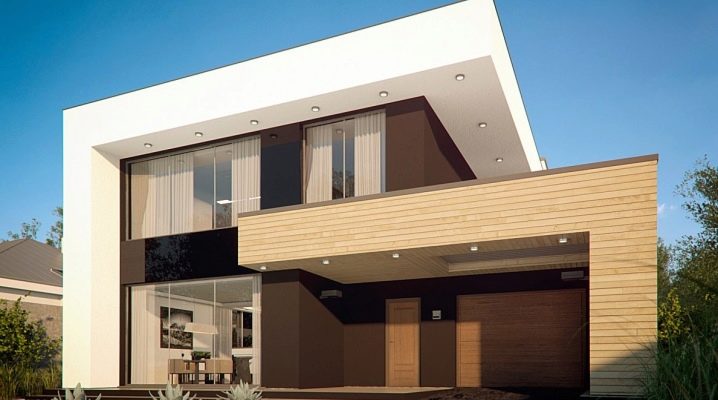
There are many roof design options for a private house. Today, along with hipped-roof structures, modern technologies and materials make it possible to create flat versions. It is worth considering in more detail what a flat roof house is, its design features, pros and cons.
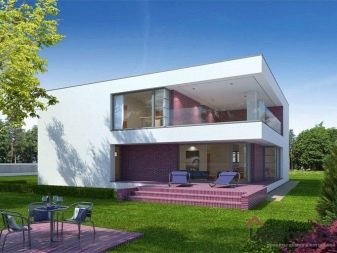
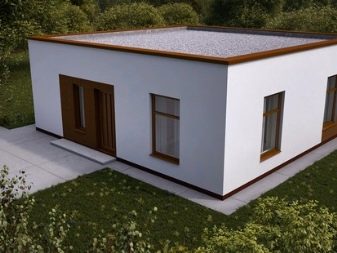
Description
Traditionally, in the temperate and northern latitudes, a hipped roof with inclined slopes was erected, which prevented the accumulation of snow cover on the surface and allowed abundant rainfall to drain down onto the rain drain system. Houses with flat roofs were common in the southern regions, where there was no heavy rain and no snow at all in winter. But the development of building technologies and the emergence of modern materials, especially waterproofing, made it possible to create a horizontal roof without problems in any region, even in the Far North.
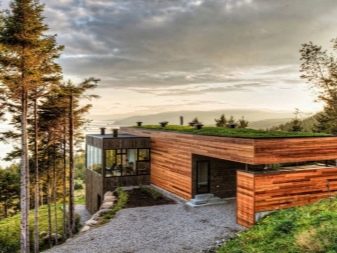
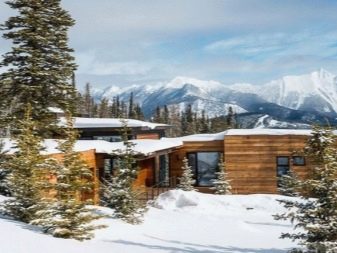
A flat roof is a floor that is located horizontally directly above the residential floors of a private house. Several layers of insulating materials that protect against moisture, cold and steam, as well as a drainage system, allow you to create reliable top protection in a one-, two- or three-story private house.
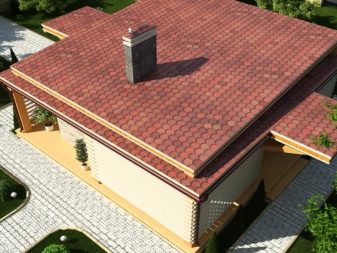
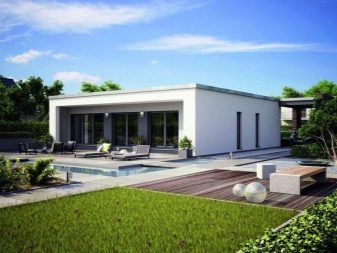
Do not be afraid that leaks will appear on the ceiling of the last floor, since with a competent approach and high-quality materials, they are completely excluded. The main thing is to properly operate such a roof and change the coating in a timely manner according to the warranty period.
For buildings with straight roofs, functionality is increased as the roof surface can be used. In many ways, the installation of such buildings is simplified in comparison with the hipped-roof options, where it is imperative to erect a rafter system. They also have a lot of other advantages.
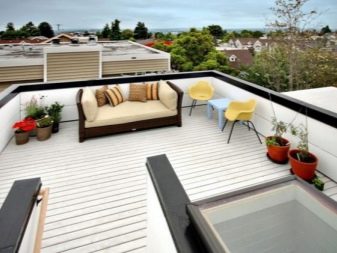
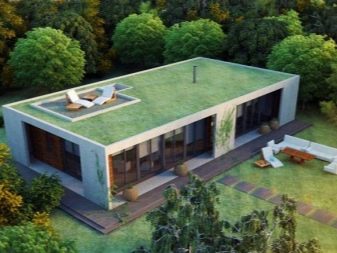
Principle and types of construction
To begin with, it is worth noting that a flat roof in a private house is not strictly horizontal, so that water does not accumulate and its drain is carried out, a surface slope of about 5-7 ° is provided. The principle here is the same as in the pitched roof weirs - they are located at a slight slope, which is invisible from the ground, but allows all the accumulated moisture to drain into the downpipe. Also on a flat roof: water collects in a certain place due to the unevenness of the surface, but the site looks horizontal, you can safely break a lawn on it or equip a recreation area.
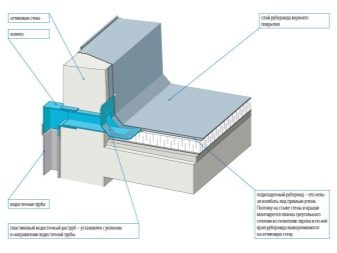
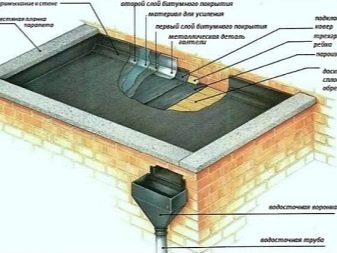
The drainage system on a similar roof contains special funnels, into which rainwater flows under the action of gravity and then, with the help of a system of hoses, goes into the sewer or underground. These devices are made of plastic that is not exposed to moisture and decay, they are mounted in layers of insulation on the roof, and they are equipped with a protective mesh on top so that the neck and drainage systems do not clog. One such funnel is designed for approximately 100-150 sq. m of roof area, from here you can calculate their total number. Usually for a small country house, 1-2 pieces are enough.
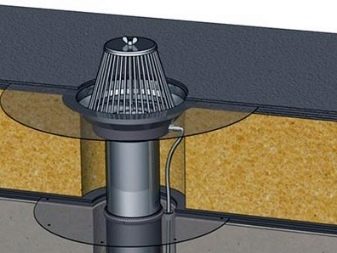

A flat roof can be exploited and unexploited. If it is practically not used, that is, it is climbed several times a year to check its integrity and maintenance, then the coating contains the following layers from bottom to top: thermal insulation, vapor barrier and waterproofing.The flooring technology here is practically the same as in residential multi-apartment and industrial buildings.
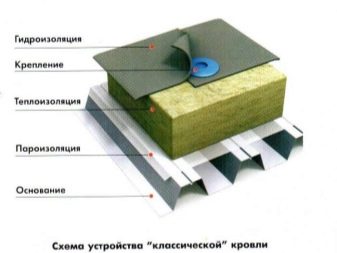
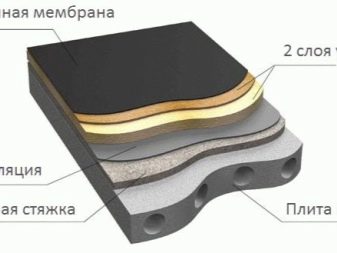
There are the following common types of unexploited flat roofs: corrugated and monolithic.
- The first option is wireframe. First, a crate made of metal profiles or wooden beams is mounted on a concrete base, insulating materials are placed in it. Then, profile metal sheets are attached to the frame. This is a relatively cheap option, easy to install, and the structure is lightweight. But it is practically impossible to walk on such a roof, because the profiles will bend and deform.

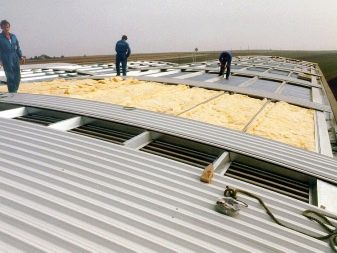
- Monolithic coating for a flat roof contains several layers. A vapor barrier film of hot bitumen is laid directly on the concrete slab, followed by mineral wool and waterproofing, and a cement-based screed reinforced with a reinforced mesh is poured on top. Such an unexploited roof will have a lot of weight, but it will reliably protect the house from precipitation and cold.

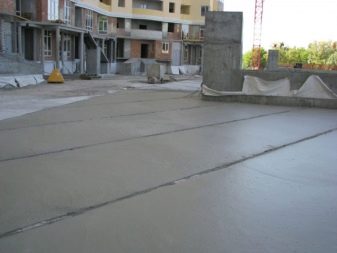
Another option, if the roof is constantly involved, people walk on it, there are some objects. Then the insulating layer changes in order: first comes the waterproofing, on top of which the thermal insulation is installed. Therefore, such a roof is called inversion.
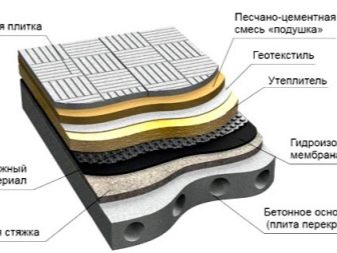

The procedure for laying materials is as follows: first, a bitumen-polymer membrane is placed on the floor slab, then a layer of foam, foam or expanded polystyrene insulation is laid. If there is a desire to create a green lawn on the roof of your house, then a separating and filtering layer of geotextile is laid on top of these insulators, and then a fertile layer on which natural grass will grow.
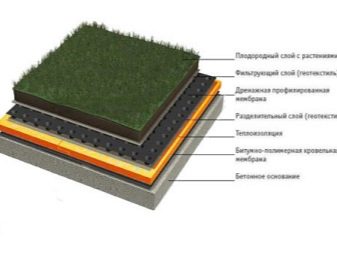
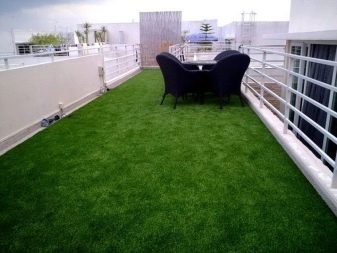
Such a roof with a fertile layer can be freely operated throughout the warm period, with a properly installed drainage system, it is not afraid of rains. On the roof you can place a playground or a sports ground, put sun loungers or benches, make flower beds and even have a picnic. Operated green roofs are now common not only in country houses, but also in city houses.


Arrangement of a flat roof does not end with flooring and pouring insulating layers and laying drainage systems. For proper operation, it is necessary to create ventilation. Moisture and its vapors can accumulate between the layers of insulation, later, during frost, the insulation cake can crack, bubbles appear on it, and delamination occurs. In order to avoid this, aerators are used - plastic or metal tubes with umbrella-shaped caps, which are mounted inside the roofing. The air entering through them, due to the pressure difference, erodes water vapor from the insulation layers, they remain completely dry.
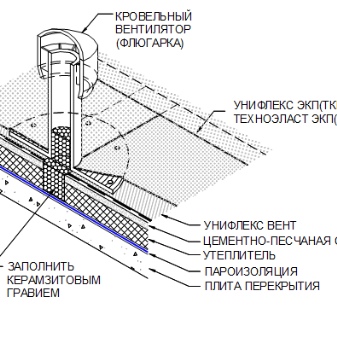

Another important point after flat roofing is the construction of lightning protection. It should not be neglected, since, despite the low probability of occurrence, a thunderstorm can lead to the most catastrophic consequences in a country house. The lightning protection mesh is installed inside the insulation layers, if they are not combustible, or if they are combustible, on top of them on special holders at a height of 10-12 cm from the surface. All nodes of this mesh are connected into one lightning rod made of thick conductive wire, which goes to ground.


Advantages and disadvantages
Low-rise buildings with a flat roof, built according to various projects, have been in operation in our country for more than a year. Feedback from owners who have lived in such houses for several years will help highlight all the advantages and disadvantages of such structures.
They have the following advantages:
- saving materials - no need to build a complex rafter system, and roofing work is simplified;
- speed of construction in comparison with gable and even more hip roofs;


- ease of repair and replacement of roofing;
- the device of a flat roof allows you to make a platform on it for various needs: a lawn, a recreation area with a gazebo, a gym, a children's corner, etc.;


- there is an opportunity to mount windows in the ceiling, this is a very original interior design plus an additional source of natural light on the ceiling;
- roofing work will be much safer than in the case of a hipped roof;
- with strong gusts of wind, there is no risk of rupture of massive rafter structures and cladding.


According to the reviews of the owners of such houses, one can also point out the disadvantages of a flat roof:
- unlike tent structures, snow will accumulate in large volumes on such roofs in winter, which must be regularly removed by hand;
- installation of a drainage system is required;
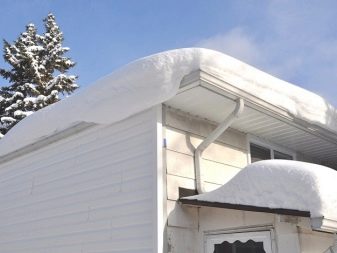

- you will need to constantly monitor the integrity of the roof, the absence of leaks;
- despite the apparent ease of installation, flat roofing has many nuances, insulator layers and gutters must be done as correctly as possible, otherwise leaks cannot be avoided.


Many projects of private houses with horizontal roofs came from Europe, where the climate is milder. Therefore, such decisions must be adjusted in accordance with our more severe weather conditions.
What to make of?
A flat roof can be made of various materials, their choice depends on the structure of the building itself.
- If the house is brick, made of gas silicate or concrete blocks, then a reinforced concrete slab can be used as a roof covering. In this case, the roof will be as strong as possible; bulky and heavy objects can be placed on it. Such a floor material is not protected from moisture, therefore, in any case, you will have to make a waterproofing layer of rolled bitumen or a screed with a lower bitumen-polymer membrane.
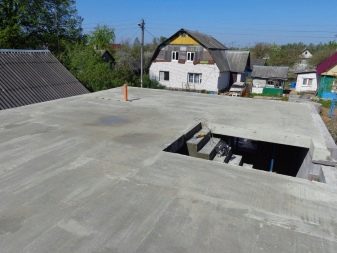

- Wooden roof slabs of a similar design will cost less than concrete ones; they can be made in a suburban area yourself. A frame with beams is installed on the walls, you can take planed beams of 10x4 cm or others as them, the main thing is that they are able to withstand the weight of future insulation and other objects located on the roof. The wood is treated with an antiseptic and a refractory solution. The roof from the bar can be covered with wood-based panels, planks or metal sheeting.
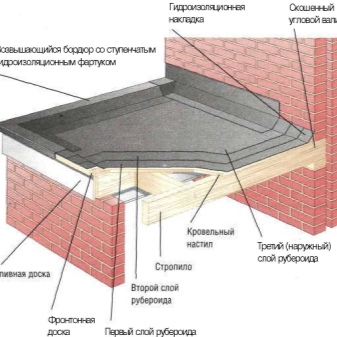

- Bitumen is traditionally used as waterproofing for houses with a flat roof. It is a hydrocarbon-based organic material that is produced by the distillation of petroleum. It has excellent waterproofing properties, is not susceptible to moisture, decay, and is not afraid of frost. The main disadvantage of bitumen is considered its non-environmental friendliness - it contains harmful components, when heated, it emits a pungent odor. Nevertheless, bituminous insulation is still in demand, including in the construction of houses with a flat roof.

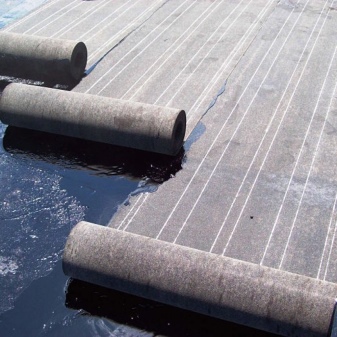
Bitumen can be rolled and liquid. Usually a combination of the two is used for maximum efficiency. First, a hot solution is poured onto a prepared cleaned surface, then rolls of solid bitumen are rolled upward. This combination allows you to close any microscopic gaps and cracks and reliably protects the roof from moisture ingress.
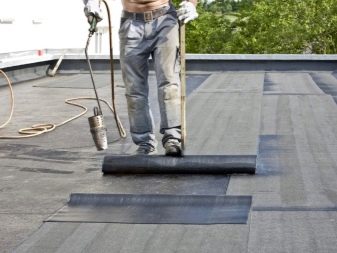
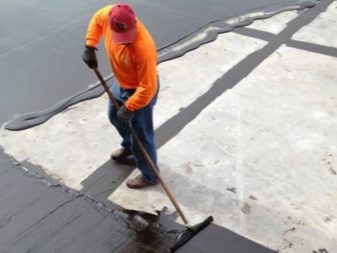
- There are other modern waterproofing materials that are cleaner and more harmless than bitumen. These include, for example, euroruberoid. It is also made on a bituminous basis, but, thanks to the synthetic fabrics and polymers in the composition, it emits less harmful substances and odors. Euroruberoid is produced in rolls, for strength it is sprinkled with special mineral chips.
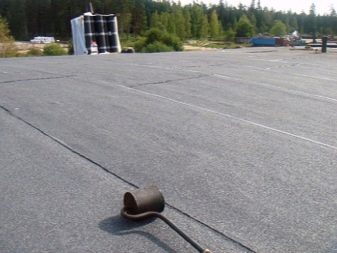
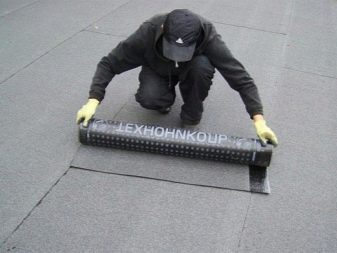
- There is a sprayable roof waterproofing in the form of powders and aerosols. It is applied to the surface using special equipment. Similar mixtures are available from plasticizers, cement, synthetic resins and hardeners. Their advantages are that they not only protect from moisture, but also reflect the sun's rays, do not let steam through.

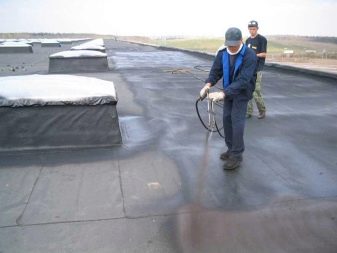
- To protect against precipitation, coating waterproofing is widely used. It, like liquid roofing material, is applied to the roof surface with a roller or brush. Among such materials, emulsion, rubber, polymer mastics and primer are especially common.
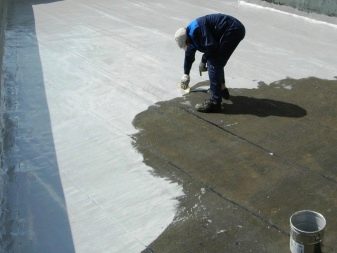
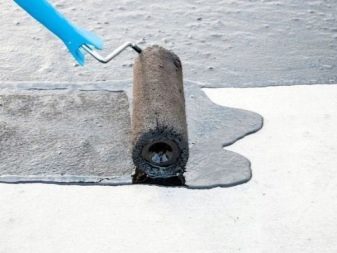
- There are options for bulk waterproofing in the form of granules that absorb moisture well and prevent it from seeping into the living space. Examples include expanded clay and crushed stone. Their advantage is that no complicated installation is required - the granules simply rise to the level of the roof, crumble and evenly smooth out over the surface.
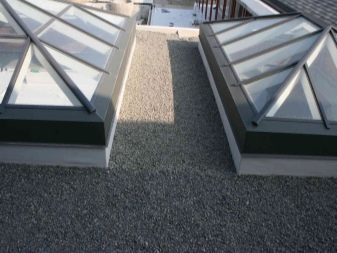
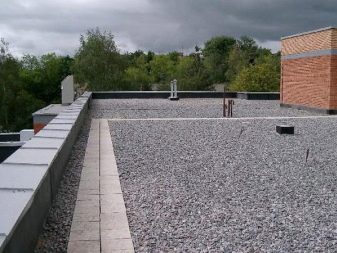
- As a vapor barrier layer, a polyethylene film with a thickness of 0.1-0.5 mm is usually used, which is laid over the entire width of the roof under the heat-insulating layer. To protect against the cold, many effective materials are used: mineral wool, polystyrene, polystyrene foam, expanded polystyrene and others.
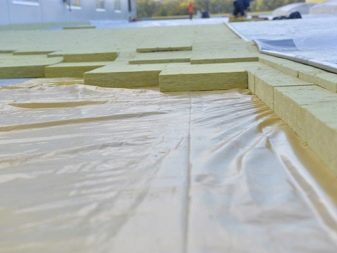
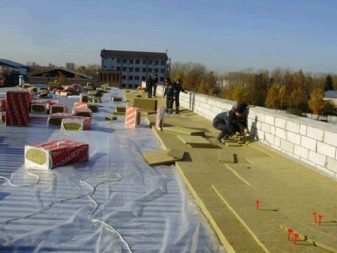
- Solid glass roofs are very impressive and impressive in appearance. The transparent ceiling in the house visually enlarges the space, creates a unique airy atmosphere, the rooms are always as light as possible. It is not very difficult to mount such floors, it is enough to create a frame from metal profiles or wooden frames and glaze it. But the operation of the glass roof becomes more complicated, in winter it is necessary to constantly clean it from the snow cover. Therefore, it is best to make a solid floor with small skylights.
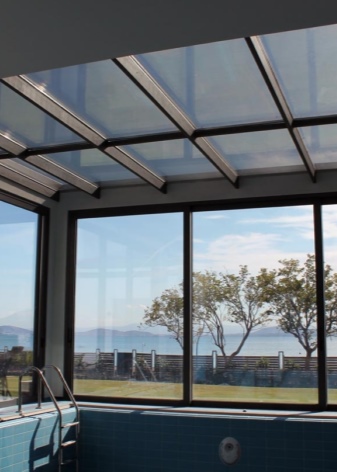
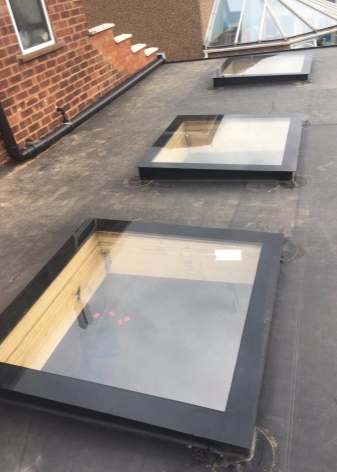
Design options
A flat roof can be installed both in a one-two-storey house with a small area, and in a spacious cottage. In a large building, you can combine a pitched hipped roof with a horizontal one, for example, using it for an outbuilding or veranda. Roofs can also be different in shape: square, rectangular and more complex. The main thing in a non-standard project is to correctly calculate the slopes and the weir system so that moisture does not accumulate on the surface.
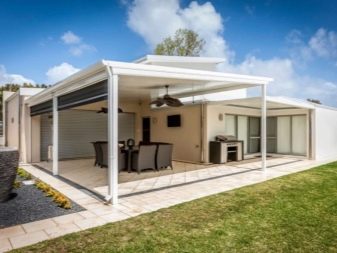
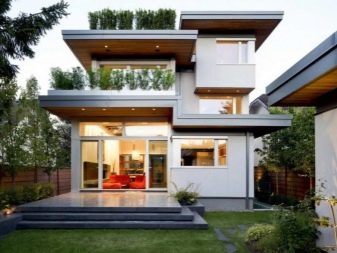
An inverted flat roof can be used for air conditioning, ventilation systems, television antennas, communication boxes and other equipment. If the roof is to be used as a platform for recreation or other active pastime, then it is necessary to mount a fence along its edges.
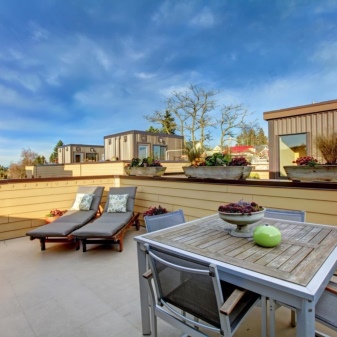

Also, when installing such a roof, you should immediately take care of a convenient rise upward with a railing. There are many designs for a used inverted roof with blueprints to guide you when building your home.
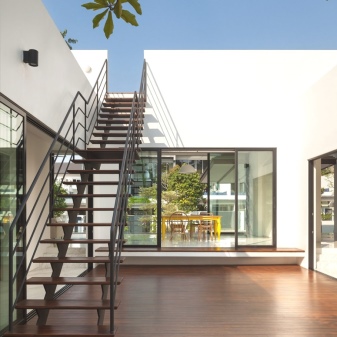
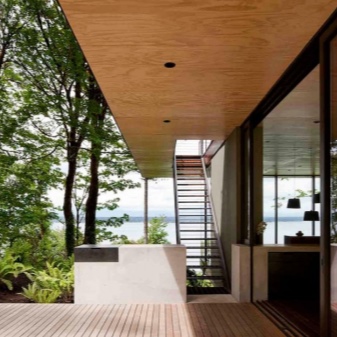
Installation instructions
Before the construction and arrangement of a flat roof, it is worth breaking down the plan of all work step by step.
- It begins with the choice of the shape, type and materials for the overlap. It should be borne in mind that the load on such a structure is always more intense than on the tent options. Based on this, you need to make a drawing of the frame system with beams and ceilings. The sketch indicates the geometric shapes, sizes, colors, materials, necessary communications. It is best to immediately have a visual idea of what the future roof will look like for your home.
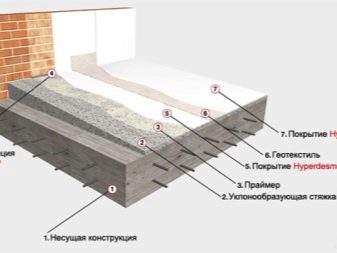
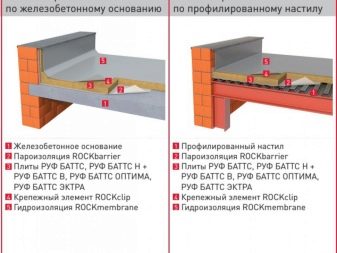
- Then you need to make a choice of the future insulation coating. In this case, it is worth being guided by the existing climate, the peculiarities of the overlap of the upper floor, the purpose of the roof - whether it will be operated or not. Preference should be given to modern polymer materials, roll or spray. They must have high insulating characteristics, at the same time be harmless.
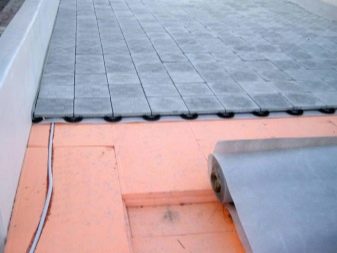
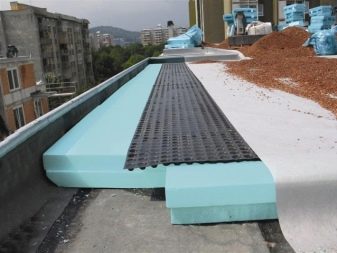
- If you have to make a frame roof, then the installation of the lathing begins with the preparation of the rails, their sawing. All preparatory work: polishing, coating with protective varnishes, marking and cutting must be carried out on the ground, in a specially equipped area. For lifting the fragments of the frame and mounting on the roof, it is imperative to use strong and fixed scaffolding with wide platforms. Work should be done in clear and dry weather.
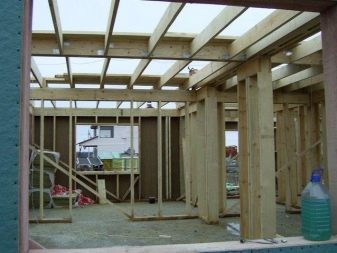
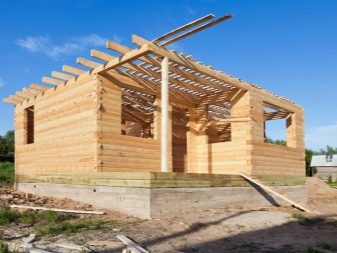
- Next, an overlap is installed on the frame and an insulating pie is mounted. Before covering with insulating layers, it is necessary to install a drainage system with funnels and drainage hoses, provide ventilation holes and aerators, a lightning rod system. To achieve maximum protection of the roof from moisture, it is necessary to ensure the tightness of all joints and abutments. They must be additionally treated with mastic, sealant or insulating tape.
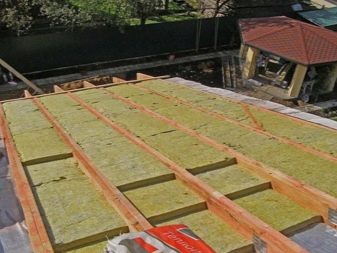
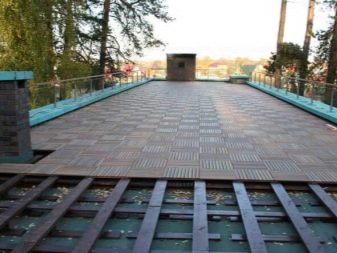
After all protective layers are installed, the roof can be equipped in accordance with your project: make fences and railings, add a fertile layer and plant green spaces, put furniture and other items.
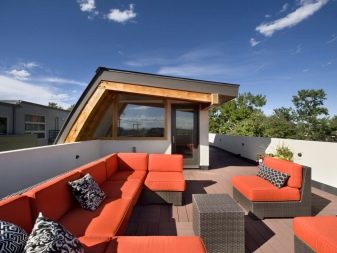
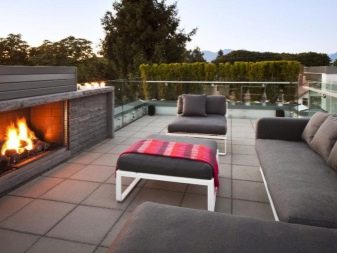
It is quite possible to install a flat roof with your own hands, having scaffolding, the necessary materials and a set of available tools: a hacksaw, a hammer, a drill, a tape measure, a level and an assembly knife.
Examples of effective design
A flat roof in a private house can be presented in a variety of ways. Some examples, created with your own hands in a suburban area, are worth considering in more detail.
An unexploited flat roof in a one-story annex of a private house. Effective insulating materials allow for a simple and elegant design with an irregular shape. The shiny surface reflects the sun's rays well, and moisture does not accumulate on the roof during rain.
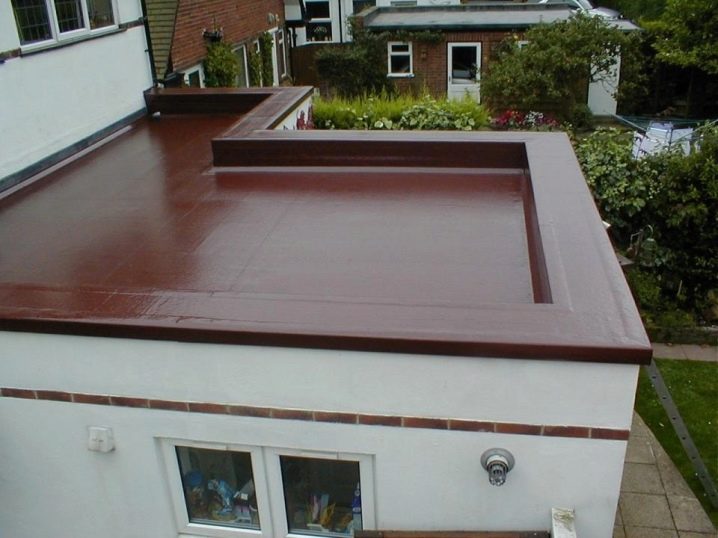
The high-tech roof of the building is very spacious and has an unusual shape. The site is not used for a recreation area, only solar panels are placed on it. If necessary, you can put other devices and communications on it.
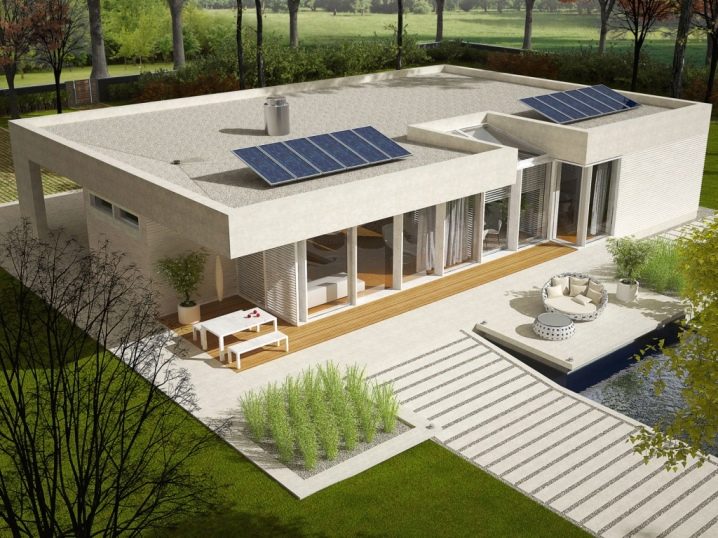
Flat roof terrace over the garage. The project is interesting in that you can enter the upper platform directly from the living room on the second floor of a country house.
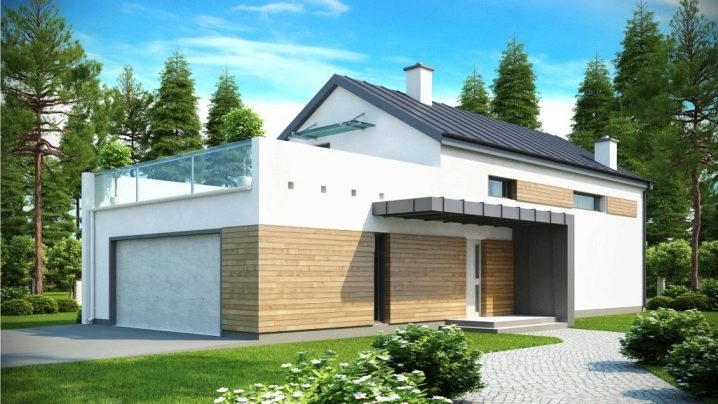
Modern technologies even make it possible to create a swimming pool on the roof of a country one- or two-story house. It is not as difficult as it seems: it is enough to choose effective waterproofing materials, install a ceiling that can withstand the weight of a bowl with water and lay a drainage system. But such a project will be really impressive.
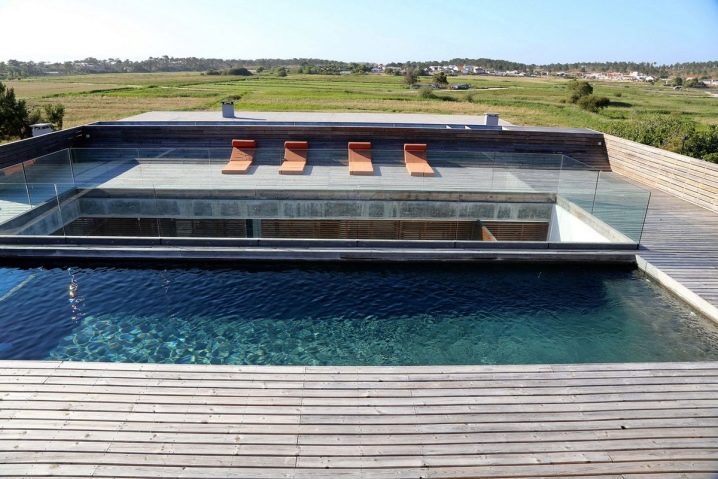
A country house with a flat roof will become much more comfortable if you break a full-fledged lawn on it. Insulation materials and a fertile layer are not very expensive, and the result is a wonderful recreational area.
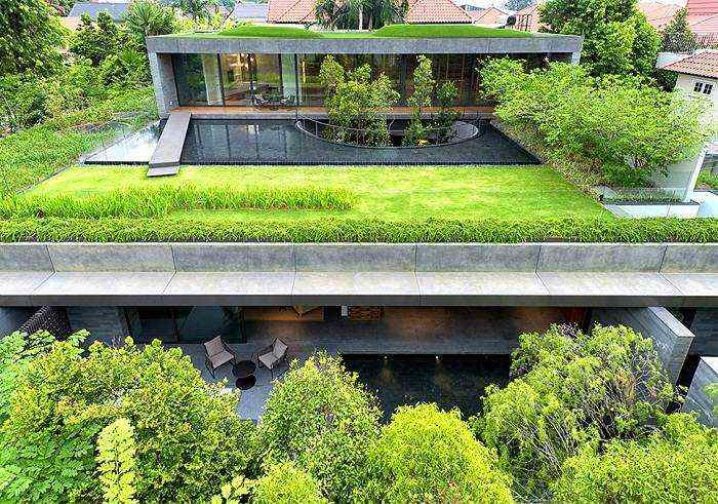
For information on how to mount a flat roof, see the next video.













Very informative. He emphasized a lot for himself. It's strange that my first comment ...
Thank you for the article.
Nice article, thanks.
The comment was sent successfully.